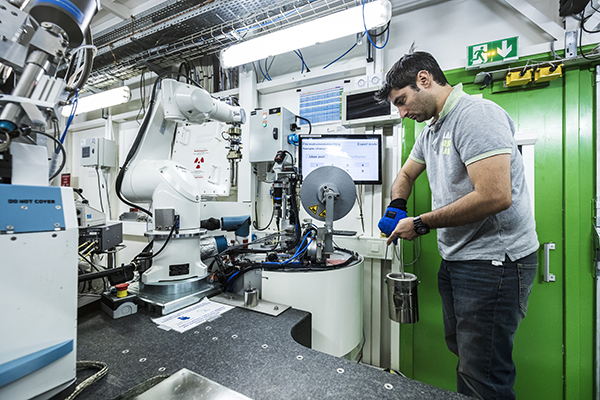- Home
- News
- General News
- How does the body...
How does the body avoid multiple sperm fertilising an egg?
14-03-2024
With the help of the ESRF, researchers from Karolinska Institutet (Sweden) have discovered the reproductive mechanism that permanently blocks polyspermy — a pathologic condition that arises when more than one sperm fuses with the egg, and which is lethal for embryo development. They also revealed the atomic architecture of the egg coat, which explains a set of genetic mutations causing infertility and it could make an impact in the development of non-hormonal contraception. The results are out today in the journal Cell.
Infertility affects around 15% of couples worldwide, according to the World Health Organization (WHO). Some cases of infertility are associated with mutations in the genes that are responsible for egg coat formation. The egg coat, also known as zona pellucida (ZP), is an extracellular matrix essential for egg growth, fertilization and protection of the embryo until it implants into the uterus. The ZP consists of several proteins, which polymerize into long filaments that form a 'mesh' around the egg. Mutations in ZP proteins may cause defects or lack of this mesh.
It is currently unclear how many of them carry pathogenic mutations in ZP genes, because not all infertile women have their genome sequenced. However, several different types of such mutations have been reported to date.
“We need to understand the processes that take place during fertilization at the molecular level”, says Luca Jovine, professor at Karolinska Institutet in Sweden and leader of the study. Together with researchers from Osaka University, Sophia University in Tokyo and University of Pittsburgh, as well the ESRF, they have found how ZP filament rearrangement prevents the fertilization of an egg by more than one sperm.
Until today, scientists knew that, after a sperm fuses with the egg, the egg releases an enzyme that specifically cleaves a major ZP protein called ZP2. Also, it was long known that the egg coat becomes ‘harder’ after fertilization, and sperm can’t penetrate it anymore. However, the connection between these processes and the basis of the block to polyspermy remained unclear. “We knew that these events were associated, but a molecular mechanism linking the different pieces of the puzzle was missing”, explains Jovine.
The team aimed to investigate the structure of ZP2 before and after the cleavage triggered by egg-sperm fusion, and how ZP2 cleavage may change the overall structure of the ZP mesh. To do so, they determined different ZP2 and egg coat filament structures using X-ray crystallography at the ESRF, Diamond Light Source and BESSY II, as well as cryo-electron microscopy at SciLifeLab in Stockholm. The team has been a regular user of the X-ray crystallography beamlines at the ESRF for more than 15 years. Daniele de Sanctis, scientist in charge of beamline ID29 at the ESRF and co-author of the study explains: "Seeing the atomic details of such a fundamental process of life is simply amazing. Throughout the years, we have been applying the state of the art of what the ESRF beamlines could offer to solve the structure of the molecular bricks that compose ZP”.
Jovine and colleagues discovered that cleavage of the part of ZP2 that protrudes from the egg coat filament allows it to form new interactions with other ZP2 molecules. These interactions create an extensive network of cross-links that bring filaments closer to each other. By stiffening the egg coat and tightening its mesh, this prevents additional spermatozoa from penetrating the ZP. “It is like a zip that is being done up”, says Jovine.
Mechanical system
The system does not block polyspermy by abolishing sperm binding to the ZP (as it was previously believed), but rather by hindering sperm penetration of the egg coat. “The mechanical system that we discovered is very logical from an evolutionary point of view, because it permanently blocks sperm in a way that does not depend on how this attaches to the egg coat, which may vary in different species”, explains Jovine.
 |
|
Daniele de Sanctis, scientist at the ESRF and co-author of the publication, setting up an experiment on the beamline. Credits: S. Candé. |
Whilst these findings are at a fundamental level, they have important implications for future reproductive medicine: “For the first time we have a molecular view of how the egg coat changes its architecture after fertilization and how this affects its function. This knowledge allows us to interpret the growing number of human ZP gene mutations linked with female infertility”, explains Jovine. “At the same time, since the egg coat is required for fertility in vivo, detailed information on its structure could have diagnostic applications and may, in principle, be exploited for developing non-hormonal contraceptives”, he concludes.
The ESRF structural biology beamlines have played a very important role in this pursuit. Back in 2017, they provided the first example of how egg coat and sperm recognize each other at the beginning of fertilization and in 2010 they solved the 3D structure of ZP3, another major egg coat subunit that is also thought to act as a receptor for sperm. “We are now already planning for new experiments that the new Extremely Brilliant Source at the ESRF has made possible”, concludes De Sanctis.
Reference:
Nishio S. et. , Cell 187:1440-1459 (2024) https://doi.org/10.1016/j.cell.2024.02.013
DOI 10.1016/j.cell.2024.02.013
Text by Montserrat Capellas Espuny
Top image: Artistic depiction of how fusion of a sperm with an egg at fertilization triggers a cascade of events that ultimately zips up the filamentous matrix around the egg, thus permanently blocking polyspermy. Credits: Marcel Bokhove.



